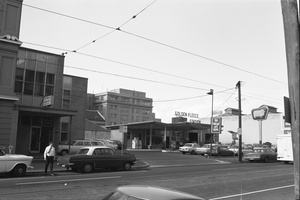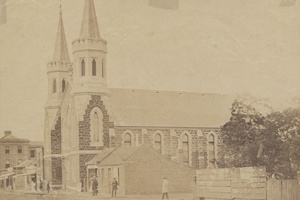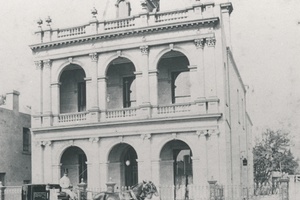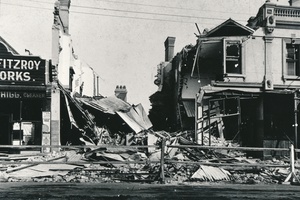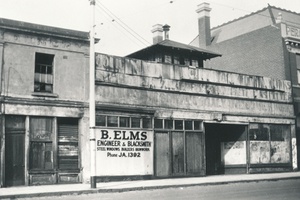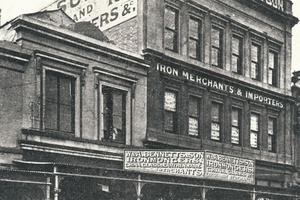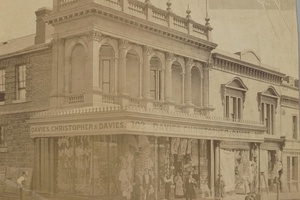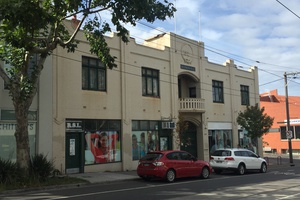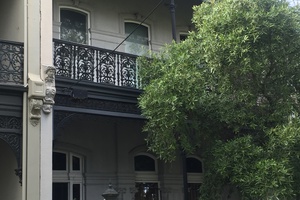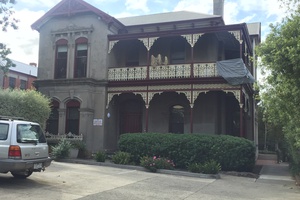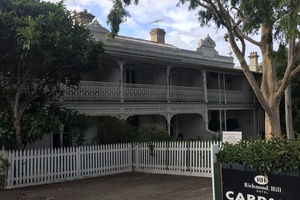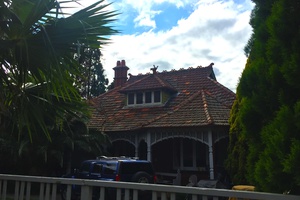This item is a part of these Tours
Brunswick Street - Then and Now
Jump To TourThis record is a stop on a tour which goes to other places. Pick up the tour by jumping to it from here. Check the map to see where it goes. You can jump back to this place later.
Other content from this author
-
Former Golden Fleece Petrol Station
Former site of Golden Fleece Petrol Station, now part of the Australian Catholic University.
LWyatt
-
Former Methodist Church and Hall
Site of the former Methodist (later Wesleyan) Church. The church was demolished in 1969 to make way for the Atherton Estate.
LWyatt
-
Former Residence of Dr Heffernan
The house pictured was constructed in 1895 for Dr Edward Bonaventure Heffernan, who used the building as private residence while also operating medical offices from the premise. By 1910 the building was being operated as a Private Hospital by Miss Gretta Lyons. The house was demolished in 1956.
LWyatt
-
83 + 85 Brunswick Street, Fitzroy
During March 1910, a gas line exploded destroying the buildings at 83 and 85 Brunswick Street. Numbers 81 and 87 were also damaged as a result of the explosion.
LWyatt
-
184-186 Brunswick Street
Formerly W & A Bennetts and Sons Iron Merchants and Importers, later the British United Shoe Machinery Company, and then an inspection store for the army.
LWyatt
-
Former Soldiers’ Memorial Hall (Richmond RSL) – 399-401 Church Street
The Soldier’s Memorial Hall was constructed in 1922 to commemorate those who had died in World War One. It was constructed at a cost of £5500, with Richmond Councils’ Building Surveyor F. McMahon designing the building and overseeing its construction pro bono. This property is graded as Individually Significant under Heritage Overlay 315.
LWyatt
-
Former Soldiers’ Memorial Hall (Richmond RSL) – 399-401 Church Street
The Soldier’s Memorial Hall was constructed in 1922 to commemorate those who had died in World War One. It was constructed at a cost of £5500, with Richmond Councils’ Building Surveyor F. McMahon designing the building and overseeing its construction pro bono. This property is graded as Individually Significant under Heritage Overlay 315
LWyatt
-
'Ivanhoe' - 383 Church Street
This was the home of Joseph Bosisto, the creator of ‘Bosisto’s Parrot Brand Eucalyptus Oil’.Bosisto was the mayor of Richmond in 1864 and 1865, and represented Richmond in the Victorian Parliament. Melbourne newspaper Table Talk said of Joseph Bosisto in 1894; ‘Roughly speaking, every man, woman and child in the city of Richmond knows, or has heard of, Mr Joseph Bosisto. The young have heard of his eucalyptus oil when they suffered from infantile croup, and the old have found in it a balm in the sorrows of rheumatism and asthma. For a couple of generations, he has been known in nearly every house in Richmond where there has been illness of any sort, […] he has been the great medicine man of the place.’ The house is graded as Individually Significant under Heritage Overlay 315.
LWyatt
-
'Helensville' – 377 Church Street
Helensville was built in 1885 for the distinguished architect John Koch. Koch was appointed city architect for Richmond in 1887 and designed many building in the municipality. Designs in Richmond include Urbrae in Hoddle Street, the Spread Eagle Hotel in Bridge Road, Prince Alfred Hotel in Church Street, and a number of banks and institutional buildings. Koch is perhaps best known for his design of Labassa in Caulfield. Koch was a Richmond city councillor between 1877 and 1885, and was mayor of Richmond in 1883. He was also president of the Royal Victorian Institute of Architects between 1903 and 1904. This property is graded as Individually Significant under Heritage Overlay 315.
LWyatt
-
'Headingsley' – 357-359 Church Street
Perched on the top of the Church Street hill the house was originally been built around 1895 for the physician Dr Robert Andrew Stirling. Dr Stirling was a surgeon who worked for the Royal Melbourne Hospital from 1877 till 1915. The house was owned by a series of local physicians before it was turned into a boarding house in the 1950s. This building is graded as Individually Significant under Heritage Overlay 315.
LWyatt
-
'Doery House' – 353 and 355 Church Street
Doery House was originally constructed as two buildings during the 1850s. Number 353 was, like many of the homes on Church Street, owned by a series of medical professionals.355 Church Street, was purchased by John Mullaly, probably in the late 1850s. Mullaly had arrived in Melbourne from Ireland in 1840, working as a customs officer, before becoming second in command at Customs House. He eventually established his own private import business Mullaly and Byrne. Although he died in 1898, his family owned the house until 1917.Both properties were acquired by the Young Women Christian Association (YWCA) in 1917. The buildings were transformed into 40 rooms for accommodating young women in need of support. The building was extended multiple times over the ensuing decades, and now acts as a hotel. The iron balustrades which adorn the façades are not original to the buildings. The buildings are graded as Individually Significant under Heritage Overlay 315.
LWyatt
-
'Mullaly House' – 339-341 Church Street
This Queen Anne style building was constructed in 1907 for John H. Mullally, replacing an earlier building. The building was designed by Gerald W. Vanheems. John H. Mullaly was the son of John Mullaly, the long-time resident of 355 Church Street. This building is noted for the quality and intactness of its sweeping roof form, hips, gables, and bay windows. The design of domestic architecture was a-typical of Gerald Vanheems work, whose professional career was dominated by designs for churches, religious, and public buildings.
LWyatt
